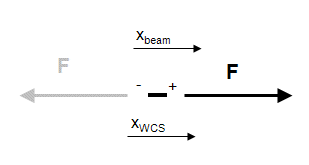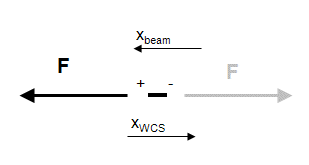Example: Resultant Force for a Simple Spring or Beam Model
The value of a spring or beam force or moment depends on how you define the spring or beam. The following example is for a beam, but the example applies equally well to a spring.
The following simple beam model is in tension. Therefore, the magnitude of the axial force is positive.
A free body diagram of a short central slice of the beam is as shown.
That is, a central slice of this beam is subjected to equal and opposite forces.
Suppose, the WCS X-direction of the model is as shown below. If you pick point A and then point B to define the beam, then the X-direction of the beam is the same as the WCS X-direction, as shown. The WCS X-direction is the same as the X-direction of the beam.
Creo Simulate reports a beam force on the positive face of the slice of the beam. The positive face of the beam has its outward normal in the same direction as the X-direction of the beam.
Therefore, in this example, FXwcs = FXbeam = F
where:
• FXwcs is the X-component of the beam force with respect to the WCS.
• FXbeam is the X-component of the beam force with respect to the X-direction of the beam.
On the other hand, if you pick point B and then pick point A to define the beam, the X-direction of the beam is reversed as shown.
Creo Simulate again reports the beam forces on the positive face of the slice of the beam:
Therefore, FXwcs = -F, FXbeam = F
Hence, the direction of the beam influences the sign of the beam forces and moments, spring forces, and moments.
Similarly, the direction of spring influences spring forces and moments.






